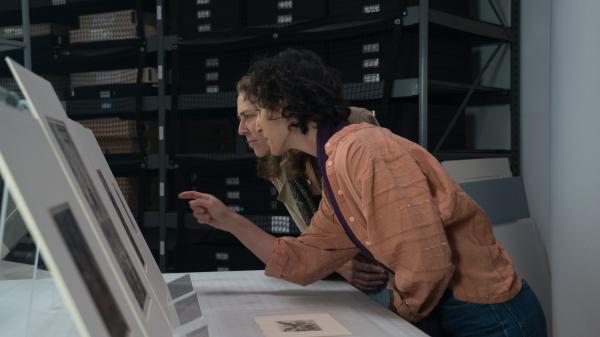Mimi Lauter is a Los Angeles-based artist who make small and large scale works on paper, primarily using pastel, a medium comprising almost pure pigment. Her work is subtly reminiscent of another time. Her use of vibrant color recalls 18th and 19th century painting. The arrangement of her drawings conveys a stained glass window in a cathedral or a medieval triptych. She is inspired by a variety of narratives, including religious stories, folklore, and mythology.
For Artists on Art, LACMA’s video and public program series featuring contemporary artists discussing objects of their choice from the museum’s permanent collection, Lauter has selected several etchings by James Ensor. She explains how she relates to Ensor’s work and its relevance to the time in which we live.

“One of the most important reasons why I chose this artist is the relevancy right now in terms of people of authority abusing their power, the masses getting revenge and getting involved; very similar stories repeating themselves. The structure in which Ensor approaches some of these issues is very much the way I approach making art. I have always looked at work historically, to understand how images are made now, what the world looks and feels like now, but through the lens of historical anecdotes and imagery. So I often look back at Ensor. He was looking into the past himself.
"Some might not know the story behind Hopfrog’s Revenge (1898). Edgar Allan Poe wrote “Hop-Frog” in the 19th century about a tyrannical king. And at the time of these etchings, the king of Brussels was King Leopold. King Leopold was large, kind of goofy, you couldn’t really take him seriously, and certainly tyrannical. He bought the Congo not even for the kingdom, it was for himself. Millions of people died and were tortured because of this. In “Hop-Frog” the story, a dwarf, called Hop-Frog, and a young woman, who was also a dwarf, are captured by one of the king’s generals and brought as a gift from lands far away. The king strikes a dwarf woman and humiliates her and Hop-Frog becomes enraged. As a way to take revenge on the king for humiliating and hurting an innocent woman, he convinces the king and seven council members to dress up as orangutans during a masquerade, then he lights them on fire and kills and simultaneously humiliates them.
“In Ensor’s Hopfrog’s Revenge (1898), we have the different characters. They are dangling from chains. Everybody is watching them. Again, the power of the masses looking at someone and making fun of them. And here we have the masses rising up. Maybe it’s not about the Hop-Frog getting revenge, but maybe everybody else getting revenge against this authority. Abuse of power and authority was something that Ensor constantly talked about in his work.
On Saturday, November 10, 2018, Mimi Lauter will be discussing the works of James Ensor and a 15th-century Dutch Book of Hours. Look for upcoming events in the Artists on Art series and view videos of past participating artists.
This conversation was edited and condensed for clarity.



